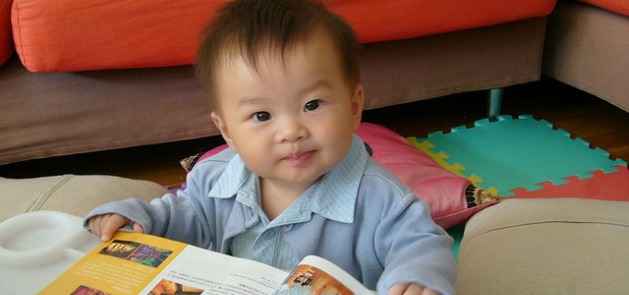|
Barbara Curtis “I didn’t grow up with the arts,” a young mom named Shelley confided over coffee some years ago. “Now I wish I had. I’d like to give my kids some exposure—but I’m not really sure where to start.” Shelley didn’t come to me for advice because of my music or art degree (I have neither), but just because I’m a mega-mom with a track record. Maybe she’d noticed my kids da-da-da-da-ing along with Beethoven’s Fifth. Or rehearsing lines from Shakespeare. Or studying a book of Chagall. Maybe she was impressed that they seemed comfortable and unembarrassed—as though Mozart was as cool as Miley. And Shelley’s hunch is right—I have had a lot to do with my kids’ love of the arts. But she’d probably be surprised to know I started out feeling pretty inadequate, asking the same questions she’s asking now. Then again, looking at my kids, how could she have known I grew up in a home where country music and black velvet paintings were the rule? That my mom was too exhausted from eking out a living to do much more than laundry on the weekend? That as a kid, I thought concerts and museums were only for school field trips? But as a young mother, I knew I was in a position to change all that for my own kids. And I knew from my Montessori training that the best time to introduce my kids to anything was the early years—when all the windows of opportunity were wide open. All this by way of saying—It’s never too early to turn your kids on to the arts, and it’s never too late for you! Music For nearly two decades, researchers have been investigating “The Mozart Effect”—which links children listening to classical music with increased intelligence. While there is no final word on the matter, as a mom who’s learned to choose classical, I can say it’s been a rich addition to our home life and broadened my children’s interest in all kinds of music. At home Try a little Mozart in the morning, a little Brahms at night. You’ll find that a background of calm classical music will even out the tone at those cranky times of day—like when you’re getting dinner ready. If you’ve always thought of classical music as something for older folks, you’ll be surprised at how even the youngest family members will prick up their ears at the first strains. If you’re not sure where to start, check the music store’s children’s section for many new classical CDs featuring works which hold the most kid appeal. There are even opera selections bundled especially with children in mind. An added blessing for believing parents—some of the most inspired classical works are part of our Christian heritage. Handel’s Messiah, for example, is a major work (3 CDs) consisting solely of prophecies about Jesus and scriptures from his life, death, and resurrection. Listening to these verses set to rich music and sung by the world’s greatest voices can be a powerful reinforcement of your family’s faith—especially at Christmas and Easter. Out and about Check your local symphony box office for concerts aimed at children—sometimes called Lollipop Concerts. These feature short, compelling works that paint a picture or tell a story, often with commentary to help reveal what to listen for. Look also for performances by young musicians. And help your children make the most of their symphony experience by an advance trip to the library for books with pictures of the various instruments, and tapes which teach how to recognize their sounds. If you know the concert program beforehand, listen to the selections a few times with your kids to familiarize them. And don’t forget dance. The Nutcracker at Christmas is a wonderful way to introduce your children to classical music. The vivid visual impressions will draw them into the music not just the first time, but each time they hear it and remember. Art If pictures are worth a thousand words to us, they’re worth a million to children. Perhaps especially to those with not-yet-extensive vocabularies. Keep in mind how children’s thinking develops. Little ones’ minds dwell strictly in the concrete. The capacity to understand abstract concepts develops gradually and is grounded in examples they’ve encountered earlier. So, for instance, a child does not understand the word bravery, but he can see it in a soldier going into battle; does not understand the word devotion, but can see it in the way a mother looks at a child. At home For children, art education begins quite simply—by seeing art in his own environment. As a Montessori teacher, I was taught to think of the environment through a child’s eyes. Imagine taking a tour of your house on your knees—what surrounds your child at his eye level? Even if you have some interesting art on your walls at your eye-level, it will be years before your children enjoy it. One easy and inexpensive way to surround your child with art is to collect note cards with famous works, especially those that have a lot of kid-appeal, like Renoir’s Girl with Watering Can or Winslow Homer’s Crack the Whip (or download and print free at the Web Gallery of Art). Buy small ready-made frames, then group your mini works of art here and there where your child is apt to spend time. If you have a reading nook, for example, hang pictures of people reading. By the coat rack, pictures of children playing outdoors. Now and then, talk about the pictures and ask your child questions: “What are the boys doing? Why are they smiling? Does it look like it will rain?” Out and about If you’re not familiar with nearby art museums, now’s a good time to get to know them better. If you are familiar, just rethink them through your children’s eyes. When you make plans to visit an art museum together, prepare your child. Explain why you need to wear comfortable, quiet shoes, to use quiet voices, to look and not touch. Don’t plan on seeing the whole museum in one visit, and be sure to take a break for lunch or a snack. Let your child set the pace (unless you need to help her slow down). When he is interested in a particular picture or sculpture, read the label nearby for the title, the artist’s name, the date, and the medium. If there’s a gift shop, let your child pick out a few postcards of the works she likes. These will be the ones she’ll never forget, the first items in her own art collection. And as with music, much of our Christian heritage is represented in classical art. There’s something very gratifying about having your child instantly recognizing the subject matter of a painting straight out of the Bible. “But she’s not wearing any clothes!” If your children are of a certain age, they’re likely to display some embarrassment over artistic nudity. Though some Christian parents may decide nudity of any kind is unacceptable, others may want give their children guidelines to help them distinguish the difference between pornography and art. With my children, I used the standard of the artist’s intent. In classical Greek sculpture, for instance, the artist’s primary motivation was interest in and appreciation of the human structure and form. Most familiar classical nudes are neither salacious nor vulgar. They are not manipulative, not intended to arouse lust in the beholder. On the other hand, pornography is clear in its intention to arouse lust and manipulate the beholder. Pornography—including television commercials which use nudity to sell anything from soap to soda pop—cannot be considered art. Drama I’ll never forget the year five-in-a-row of my kids—Josh, Matt, Ben, Zach, and Sophia—put onThe Wizard of Oz for our family. They did own production from the first idea to the last bow. Our family’s big, so it lends itself to encouraging a flair for drama in our kids. For smaller families who want to expose their kids to drama, you’ll need to seek out opportunities. Check the phone book’s yellow pages or your newspaper’s weekly events pages for children’s theater—classes, auditions, or current productions. If your children like musical theater—and what child wouldn’t?—they’ll probably enjoy a high school production ofSound of Music as much as a professional version. Whatever you do, don’t underestimate your kids’ capacity. I’ve found children as young as nine to be very receptive to Shakespeare. Even if they don’t understand every word, they understand the action and emotions. Final Thoughts Parents know that while most of us can learn more than one language, those who feel most comfortable with two languages were exposed to both from the earliest years. The same principle works in the area of the fine arts. Early exposure, even the most casual, will enrich your children’s lives now and as they grow. They’ll be comfortable in the arts—and who knows? You may discover—because God doesn’t limit our kids to the same gifts he’s given us—a budding Picasso or Pavarotti living right under your roof. From Crosswalk.com, April 2009
0 Comments
 Note to parent or teacher: Here’s a 20- to 30-minute class plan on thankfulness and overcoming whining and grumbling. (note that this plan is geared to children ages 2 to 6.) Watch “Way to Wake Up.” Discuss how it’s not fun to be around someone who whines or grumbles. Compare grumbling and whining to a smelly sock, or anything very unpleasant that your child dislikes being around. Highlight what kind of attitude people do like to be around. Watch “Look on the Bright Side.” Talk about how it can be easy to focus on the things that go wrong, but that happiness comes when you choose to focus on the good instead. Read and/or memorize the rhyme on “Poster: Think on the Good.” A coloring page for this poster is available here. Read “Bright Pebbles: So Much to Be Glad For.” Do the action activity on the last page of this article. Memorize 1 Thessalonians 5:18 (TLB): “Always be thankful!” Read “Poem: My Happy Sunbeam.” The coloring book for this poem is available here. Play the song “Sunny Sunbeam” while the children get up and dance to it (and/or enjoy it throughout the day while doing other activities). Watch “Video: The Power of a Smile.” Optional activity: Take a piece of cardboard or stiff paper, and cut it into a large circular shape to represent a sun. In the center of the circle, write “How to Get to the Bright Side”—and list ideas of things your child can do when he or she is feeling down. String a hole at the top of the circle, and hang it in a place where this craft can be easily seen. Lesson plan courtesy of My Wonder Studio. Image by Grant Cochrane, www.freedigitalphotos.net
Judy Lyden, Scripps Howard News Service
My grandson William is eight months old and standing on his own. Children are curious and will use all their senses to absorb information. William eats anything. The 24-pound tremendosaurus makes his way to his mother’s lap and opens his mouth for shoveling. If he could, he’d say, “Faster, Mom.” William would pull a tablecloth to fetch a cookie, climb into the refrigerator to peruse goodies and into closets to forage. Funny? It could be, or it could turn tragic. Young children don’t understand, and many new parents are not watchful enough. I’ve known children who drank liquid drain-clog opener and last night’s vodka punch and others who ate Mom’s deodorant. These are poisons for young children. It only takes a few seconds. Periodic safety reevaluations of all homes are advisable. Re-evaluating your home is easy when you check the council’s Web site at http://www.homesafetycouncil.org for tips.
By a father of three exceptional children I have been a special needs parent for over a decade and something that I learned along the way is that despite my very best efforts, at the end of the day, I’m only human. I get frustrated, overwhelmed, and on occasion say and do the wrong thing. One of the things that happens quite often to special needs parents is that the demand on us simply exceeds the resources we have available, be it emotional, physical, or financial. This demand is constant in many cases, and the strain over time becomes more and more difficult to carry. The stress can really take its toll. I feel that as special needs parents, we often don’t give ourselves enough credit or cut ourselves enough slack. Speaking for myself only, I have a tendency to be overly critical of myself, especially when I feel I’m failing at something, which is honestly, quite often. However, in reality, I’m failing to remember that I’m doing or trying to do things every day that most people simply couldn’t handle. We tend to become so accustomed to everything that we often focus more on our perceived losses or defeats than we do on our successes and victories. One of the things that I have always encouraged people to do is share their feelings. Venting, or expressing what we are going through, is something that is extremely important in special needs parenting. Again, speaking only for myself, I’m under constant and unforgiving pressure. These pressures can range from health or behavioral issues to simply trying to make ends meet. Some of this pressure I put on myself, but most of it is inherent to special needs parenting in general. There are times that my kids drive me crazy and I swear that my head is going to explode. For a long time this was like a double-edged sword. I would be so incredibly stressed out, overwhelmed, and frustrated. On top of that, I would feel an extreme sense of guilt for being stressed out, overwhelmed, and frustrated. The kids had no control over most of their behaviors, but I had this idea that, as their father, I was supposed to have this never-ending supply of patience. Instead I was always “a day late and a dollar short.” There were times that I was so far gone that I would go through a drive-thru to pick up dinner and when asked, “Can I take your order?”, I would answer, “I’ll take some sanity with a side order of patience and some peace and quiet for desert…oh…and…supersize that.” Apparently, this kind of stuff is not on the menu…anywhere! Trust me, I’ve tried everywhere. You can ask my wife. She was always mortified when I would place my order. Then one day, it hit me. I’m not sure how or why this happened, but I realized that I didn’t have to feel guilty for being frustrated, overwhelmed, and stressed out by my kids or their behavior. I guess I had felt like if I admitted that I was frustrated or overwhelmed by the challenges associated with raising three boys with special needs, that it somehow reflected poorly on them, or that I loved them less. I didn’t want anyone to think that about my kids because, while challenging, they are totally awesome, and I wouldn’t trade them for anything in the world. Admitting frustration with those challenges, or even with any or all of my kids, doesn’t mean they are bad and it certainly doesn’t mean that I somehow love them any less. What admitting this did mean however, was that I was human. I learned that not only was it normal to feel these things, but it was also healthy. This was such a powerful realization for me, and it changed my perspective considerably. I discovered that acknowledging these feelings, and even embracing them, provided a much-needed sense of relief. The relief really kicked in when I became comfortable enough with these feelings to not only admit them to myself, but share them publicly as well. While that may not appeal to everyone, and understandably so, it helped me to keep myself centered. I think that this is something particularly difficult for fathers. Society tells us that we are supposed to be almost emotionless and not feel these things and if as a man, you actually do have these feelings, God forbid you ever admit it. Look, we are human beings living in very difficult situations. These situations very often require sacrifice to the nth degree. Feeling frustrated, overwhelmed, or even resentful is completely normal, at least in my opinion. I also think that admitting these things is not a sign of weakness or even bad parenting. In fact, I would argue that it shows great courage and a deep unconditional love for our kids. Honestly, no one likes admitting things like this, but in doing so we get a better understanding of our limitations and ourselves. As far as I’m concerned, this helps to make me a better parent, and speaking for myself, I need all the help I can get. Article courtesy of Motivated magazine. Used with permission. Photo by David Castillo Dominici/FreeDigitalPhotos.net.
Taken from Grow Up Reading
The developmental changes in babies from birth to 24 months are substantial and dramatic! At birth, babies rely on crying as their primary means of communicating and interacting with the world. As they grow, babies begin to use gestures, vocal and facial expressions, exclamations, babbling, and finally words to communicate with others. Good language skills help children grow into literate adults who can read and write proficiently. Parents can help babies become successful learners and readers by developing the following early literacy skills starting at birth. Oral language skills: Babies learn language in stages. During the first four months, babies are primarily on the receiving end of language. During the next four months, babies begin to initiate and imitate sounds. By eight months, a baby responds to her own name, distinguishes emotions by the tone of voice, responds to sound by making sounds and uses her voice to express joy and displeasure. By 12 months, a baby is paying increased attention to speech and responds to simple verbal commands. She is starting to use simple gestures such as waving “bye-bye” or shaking her head “no.” She babbles with inflection and uses exclamations such as “uh-oh,” and may say a few words such as “mama” and “dada.” One-year-olds can typically say six or seven words (although many speak none at all, while others might speak up to fifty) and understand close to seventy words. There is usually a five-month lag between a child’s understanding of words and his or her ability to speak them. Between 12 to 18 months, a child’s vocabulary slowly, but steadily increases. Most children’s vocabulary explodes once he or she can say about four dozen words. By the age of two, children typically learn the meaning of eight new words a day. The more parents talk and read to their baby, the more rapidly their baby’s vocabulary develops. According to early childhood experts, language skills grow faster in children whose parents use positive rather than negative feedback. Phonemic awareness: Being aware of phonemes—the smallest, unique sounds that make up words—is the basis for learning to speak and to read. Babies are quite skilled at detecting differences in sounds. This is why children are “wired” for learning multiple languages in the early years. Babies become aware of phonemes and learn to differentiate the sounds that make up speech through interactions with parents and other caregivers. Help your baby develop phonemic awareness by talking and reading to your child every day. Encourage your baby’s babbling, which helps him to learn language. At about two months, babies begin to coo, using vowel sounds like “aaah” and “oooh.” At five or six months, babies begin to practice sounds with consonants (b, d, j, m, n, and w are the most common). One-year-olds begin to combine vowel and consonant sounds into words. Comprehension: Comprehension is central to the process of reading. While comprehension is reinforced in the later years when an older toddler and preschooler can follow the pictures and text to understand the meaning of a story, it is important to talk about what is happening in the books you read aloud to your infant. According to Jim Trelease in The Read-Aloud Handbook, “Listening comprehension feeds reading comprehension.” As your baby listens to you read, point out clues about the story in the illustrations or relate a picture to something in your baby’s life. By using strategies like these, you stretch your baby’s thinking skills and encourage greater comprehension. Author Unknown Each exceptional child is different, of course, but here’s something that one such child might want to tell you—if they could. Spend time getting to know me. Please have patience with me. I may not be able to do the things another child can. Enjoy learning about my special needs so that you will understand. Care about what my parents or caregivers tell you about how I communicate. Imagine your child having problems, then realize what my parents feel. Always be kind to people who are disabled. We are just like you. Listen to me. I may be hard to understand, but if you take the time, you can understand me. Never blame my parents. They didn’t do anything wrong or cause me to be the way I am. Encourage my parents and caregivers. They need it. Entertain me, so that my parents or caregivers can have some time off. Distraction is part of my daily life. I can’t sit still. I try, but I can’t. Screaming is what I sometimes do when I can’t handle what is going on around me. I want to tell you what is wrong, but I can’t. Courtesy of Motivated magazine. Used with permission.
The American businessman was at the pier of a small Mexican coastal village when a small boat with just one fisherman docked. In the boat were several large yellowfin tuna. The American complimented the Mexican on the quality of his fish and asked how long it took to catch them.
The Mexican replied, “Only a little while.” The American then asked why he didn’t stay out longer and catch more fish. The fisherman said he had enough to support his family’s immediate needs. The American then asked, “But what do you do with the rest of your time?” The fisherman said, “I sleep late, fish a little, play with my children, and take a siesta with my wife Maria. Then I stroll into the village each evening where I sip wine and play guitar with my amigos. I have a full and busy life, señor.” “I am a Harvard MBA,” the American scoffed. “I could help you. You should spend more time fishing. With the proceeds you could buy a bigger boat. With the proceeds from the bigger boat you could buy several boats. Eventually you would have a fleet of fishing boats. Instead of selling your catch to a middleman you would sell directly to the processor, eventually opening your own cannery. You would control the product, processing, and distribution. You would need to leave this small coastal fishing village and move to Mexico City, then Los Angeles, and eventually New York City, where you would run your expanding enterprise.” The fisherman asked, “But señor, how long will this all take?” “Fifteen or twenty years.” “But what then, señor?” The American laughed and said, “That’s the best part. When the time is right you would sell your company stock to the public and become very rich. You would make millions.” “Millions, señor? Then what?” The American said, “Then you would retire and move to a small coastal fishing village where you would sleep late, fish a little, play with your grandchildren, take siestas with your wife Maria, and stroll to the village in the evenings where you could sip wine and play your guitar with your amigos.”—Author unknown |
Categories
All
Archives
March 2024
LinksFree Children's Stories |







 RSS Feed
RSS Feed
